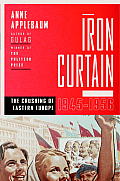 Iron Curtain tells the detailed, inside story of how Stalin and his minions spread their post-WWII poison of oppression throughout Eastern Europe. Anne Applebaum’s scrupulously detailed, country-by-country account of the Marxist-Leninist domination of every facet of the lives of millions of people is an amazing and chilling story.
Iron Curtain tells the detailed, inside story of how Stalin and his minions spread their post-WWII poison of oppression throughout Eastern Europe. Anne Applebaum’s scrupulously detailed, country-by-country account of the Marxist-Leninist domination of every facet of the lives of millions of people is an amazing and chilling story.

I’ve read a great deal on this subject. More than I want to really, because I have a friend who is obsessed with it, and feeds me books, and I read them. I’m lucky he feeds me only those he considers the very best. What’s different about this one is that it isn’t just a catalog of slaughters and torture, though there is a good measure of that. Instead, Applebaum concentrates on the internal mechanisms by which communists viralized (how’s that for a new word?) their philosophy through the societal body of each country they invaded. And did so in a way fashioned around the proclivities of the nation in question. People in all of these countries had been under Nazi domination for years, and many people in each of them saw the Soviets as liberators. Many of them actually believed in the Marxist-Leninist philosophy and looked forward to helping create a true proletariat state. And, in a few countries, there was in the beginning a glimmer of such an ideal. Soon, though, the Stalinists took over. No one was more true to Louis XIV’s motto “l’etat, c’est moi” than Stalin, who dealt swiftly and surely with deviants from the party line.
What the oppressors, Soviet or local, saw most clearly was not only that they needed to control the media–the press, radio, etc. That was obvious. But that they needed to control clubs and social organizations. Anything from a dancing society to a chess club to a scouting troop that might promote individual or small group initiative of any kind. Everything had to be subordinated to the go”good of the people” meaning the Stalinist state. To that end, they put their own people in charge, and/or infiltrated the organization with spies who would report untoward activity, be it speech, behavior, or humor. This, of course, created an atmosphere of intimidation and fear in which no one trusted anyone else. They were crafty and relentless about their efforts.
Applebaum provides insightful interviews with people who lived under these regimes, who either protested or accommodated or were jailed or who sailed under the radar or who accepted special privileges for use of their medical or engineering or literary skills. They all have interesting stories, some of them seemingly frank, some of them self-serving, none of them trustworthy to this reader because they are all people who survived by developing skills of duplicity.
It’s a sad story of another dimension of totalitarianism than we’re used to hearing. We, as I said earlier, are more accustomed to stories of the more overt acts of terror and death camps than to the more subtle drama of mutual betrayal and mistrust. However, they are all part of the same bloody fabric by which all such governments rule. It’s just that the Stalinists and their successors were better at it than most of their modern peers. Except the Chinese, of course. They’re the historical kings of it all as far as I’m concerned
